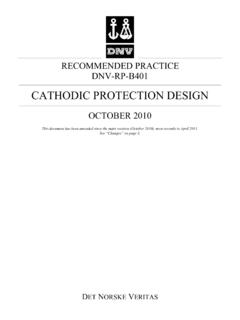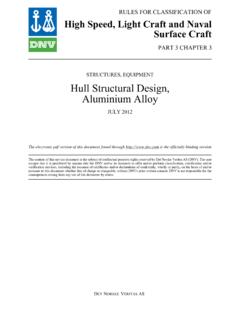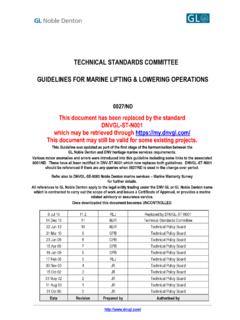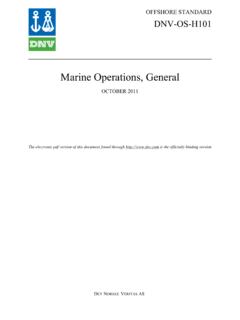Transcription of DNV-OS-E403: Offshore Loading Buoys
1 Offshore STANDARDDET NORSKE VERITASDNV-OS-E403 Offshore Loading BUOYSOCTOBER 2008 Comments may be sent by e-mail to subscription orders or information about subscription terms, please use information about DNV services, research and publications can be found at , or can be obtained from DNV, Veritasveien 1, NO-1322 H vik, Norway; Tel +47 67 57 99 00, Fax +47 67 57 99 11. Det Norske Veritas. All rights reserved. No part of this publication may be reproduced or transmitted in any form or by any means, including photocopying and recording, without the prior written consent of Det Norske Typesetting (FM+SGML) by Det Norske any person suffers loss or damage which is proved to have been caused by any negligent act or omission of Det Norske Veritas, then Det Norske Veritas shall pay compensation to such personfor his proved direct loss or damage. However, the compensation shall not exceed an amount equal to ten times the fee charged for the service in question, provided that the maximum compen-sation shall never exceed USD 2 this provision "Det Norske Veritas" shall mean the Foundation Det Norske Veritas as well as all its subsidiaries, directors, officers, employees, agents and any other acting on behalf of DetNorske NORSKE VERITAS (DNV) is an autonomous and independent foundation with the objectives of safeguarding life, prop-erty and the environment, at sea and onshore.
2 DNV undertakes classification, certification, and other verification and consultancyservices relating to quality of ships, Offshore units and installations, and onshore industries worldwide, and carries out researchin relation to these Offshore Codes consist of a three level hierarchy of documents: Offshore Service Specifications. Provide principles and procedures of DNV classification, certification, verification and con-sultancy services. Offshore Standards. Provide technical provisions and acceptance criteria for general use by the Offshore industry as well asthe technical basis for DNV Offshore services. Recommended Practices. Provide proven technology and sound engineering practice as well as guidance for the higher levelOffshore Service Specifications and Offshore Offshore Codes are offered within the following areas:A) Qualification, Quality and Safety MethodologyB) Materials TechnologyC) StructuresD) SystemsE) Special FacilitiesF) Pipelines and RisersG) Asset OperationH) Marine OperationsJ) Wind TurbinesO) Subsea SystemsAmendments and Corrections Whenever amendments and corrections to the document are necessary, the electronic file will be updated and a new Adobe PDFfile will be generated and made available from the Webshop ( ).
3 DET NORSKE VERITAS Offshore Standard DNV-OS-E403, October 2008 Changes Page 3 CHANGES GeneralBeing class related, this document is published electronicallyonly (as of October 2008) and a printed version is no longeravailable. The update scheme for this category of documents isdifferent compared to the one relevant for other Offshore doc-uments (for which printed versions are available). For an overview of all types of DNV Offshore documents andtheir update status, see the Amendments and Corrections document located at: , undercategory Offshore Codes . Main changesSince the previous edition (April 2005), this document hasbeen amended, latest in October 2008. All changes have NORSKE VERITASO ffshore Standard DNV-OS-E403, October 2008 Page 4 ChangesDET NORSKE VERITAS Offshore Standard DNV-OS-E403, October 2008 Contents Page 5 CONTENTSCH. 1 INTRODUCTION .. 7 Sec. 9A. 9A 9A 200 Objectives .. 9A 300 Organisation of the standard.
4 9A 400 Scope and application .. 9B. References .. 9B 9B 200 Normative references .. 9C. Definitions .. 10C 100 Verbal forms .. 10C 200 Terms and definitions .. 10C 10D. 11D 100 Design documentation .. 11CH. 2 TECHNICAL PROVISIONS .. 13 Sec. 1 Loading /Unloading Facilities and Arrangements .. 15A. 15A 15B. Environment and Site Location .. 15B 15C. 15C 100 Structural arrangements .. 15C 200 Separation of 15C 300 Safety 15C 400 Equipment and piping .. 15C 500 Precautions against fire .. 15D. Marking and Warning 15D 15E. Fluid Transfer Systems .. 16E 16F. Equipment Design .. 16F 16F 16F 300 Design pressure and temperature .. 16 Sec. 2 Materials and Corrosion Protection .. 17A. 17A 100 Objective .. 17B. Principles .. 17B 17C. Specific Requirements .. 17C 100 Structural materials .. 17C 200 Corrosion protection of structures .. 17C 300 Materials for pressure vessels, piping and equipment.
5 17C 400 Bolts and nuts .. 17C 500 Sealing materials and polymers .. 17D. Material Certificates .. 17D 17D 200 Type of document .. 17E. Corrosion Protection of Systems and 18E 18 Sec. 3 Structural Strength .. 19A. 19A 100 Application .. 19B. Materials and Structural Categorisation .. 19B 100 Materials .. 19B 200 Structural categorisation .. 19C. Design Loads .. 19C 19C 200 Functional 19C 300 Environmental loads .. 19C 400 Accidental 19D. Loading Conditions .. 19D 19D 200 Load 19E. Local 20E 20E 200 Slewing 20E 300 Universal joints .. 20 Sec. 4 Anchoring and Mooring .. 21A. Anchoring .. 21A 21A 200 Special provision for Loading Buoys .. 21A 21A 400 Anchor 21B. Mooring .. 21B 100 Mooring hawsers .. 21B 200 Compensators .. 21 Sec. 5 Stability and Watertight Integrity .. 22A. 22A 100 Application .. 22A 200 Draft marks .. 22B. Intact 22B 22B 200 Stability 22C. Damage Stability.
6 22C 22C 200 Exposed collision 22 Sec. 6 Piping, Equipment and Hoses .. 23A. Piping .. 23A 23B. Mechanical Equipment .. 23B 100 Bilge and sounding 23B 200 Pipe 23B 300 Lifting equipment .. 23C. Floating Hoses .. 23C 23D. Underbuoy Hoses and Pipes .. 23D 23 Sec. 7 Hazardous Area and Ventilation .. 24A. 24A 100 Application .. 24B. Specific Requirements .. 24B 24B 200 Enclosed areas .. 24 DET NORSKE VERITASO ffshore Standard DNV-OS-E403, October 2008 Page 6 ContentsSec. 8 Electrical Installations .. 25A. 25A 100 Application ..25 Sec. 9 Fire Safety .. 26A. 26A 100 Application ..26B. Specific Requirements for Offshore Loading Buoys .. 26B 100 General ..26B 200 Unmanned 300 Not permanently manned Buoys ..26 Sec. 10 Control Systems .. 27A. 27A 100 Application ..27B. Basic Requirements .. 27B 100 Control of fluid transfer ..27B 200 Communication ..27C. Gas Detection 27C 100 General ..27D.
7 Alarm System .. 27D 100 General ..27 Sec. 11 Manufacture, Sea Transport and Commissioning .. 28A. 28A 100 Application ..28B. Manufacture of Equipment and 28B 100 Pipe swivel ..28B 200 Torsional Installation and Commissioning .. 28C 100 Installations ..28C 3 CERTIFICATION AND CLASSIFICATION 29 Sec. 1 Certification and Classification .. 31A. 31A 100 Introduction ..31A Certification .. 31B 100 General ..31C. Classification .. 31C 100 General ..31C 300 National regulations ..31 Sec. 2 Design Approval .. 32A. 32A 100 General ..32B. 32B 100 Design Stability and Watertight Integrity .. 32C 100 General ..32D. Piping, Equipment and Loading Hoses .. 32D 100 Torsional Survey Arrangement .. 32E 100 General ..32 Sec. 3 Certification of Materials and 33A. Certification of 33A 100 General ..33B. Certification of Components and Equipment .. 33B 100 General ..33C. Equipment Categorisation .. 33C 100 General.
8 33 Sec. 4 Survey during 35A. 35A 100 General ..35 Sec. 5 Surveys at Testing and Installation .. 36A. Pre-commissioning .. 36A 100 General ..36 Sec. 6 Classification in 37A. 37A 100 General ..37 DET NORSKE VERITASV eritasveien 1, NO-1322 H vik, Norway Tel.: +47 67 57 99 00 Fax: +47 67 57 99 11 Offshore STANDARDDNV-OS-E403 Offshore Loading BUOYSCHAPTER 1 INTRODUCTIONCONTENTSPAGESec. 1 Introduction .. 9 DET NORSKE VERITAS Offshore Standard DNV-OS-E403, October Page 9 SECTION 1 INTRODUCTIONA. GeneralA 100 Introduction101 This standard gives criteria and guidance on design, fab-rication, installation and testing of Offshore Loading Buoys . 102 The standard applies to floating ( buoy ) systemsintended for Loading / unloading of fluid cargoes such as crudeoil, petroleum gas etc. into/from ships or other units in The standard has been written for general worldwideapplication in benign waters. Buoys intended for harsh envi-ronment use shall be subject to special consideration.
9 Governmental regulations may include requirements in excessof the provisions of this standard depending on the size, type,location and intended service of the Offshore Loading note:In the context of this Offshore Standard benign waters is definedas areas with significant wave height less than m with a prob-ability of exceedance of 10-2 (100 years return period). ---e-n-d---of---G-u-i-d-a-n-c-e---n-o-t- e--- A 200 Objectives201 The objectives of this standard are to: provide an internationally acceptable standard of safetyfor Offshore Loading Buoys by defining minimum require-ments for the design, materials, construction and commis-sioning of such objects serve as a technical reference document in contractualmatters between suppliers and purchasers serve as a guideline for designers, suppliers, and purchas-ers specify requirements for Offshore Loading Buoys subject toDNV certification and 300 Organisation of the standard301 This standard is divided into three main chapters: Chapter 1: General information, scope, definitions andreferences.
10 Chapter 2: Technical provisions for Offshore loadingbuoys for general application. Chapter 3: Specific procedures and requirements applica-ble for certification and classification of Offshore loadingbuoys in accordance with this 400 Scope and application401 The standard covers the following systems and arrange-ments, including relevant equipment and structures: arrangements loads and load effects structural strength anchoring and mooring stability and watertight integrity hazardous areas and ventilation marine machinery and piping electrical installation fluid transfer system and equipment instrumentation and control ReferencesB 100 General101 In case of conflict between requirements of this standardand a reference document, the requirements of this standardshall prevail. 102 For undated references, the latest edition of the refer-enced document (including any amendments) applies. Fordated references, the edition cited applies.



















